The String of Rubies is a beautiful, trailing succulent with plump, ruby-red leaves. It’s an excellent choice for those looking to add a vibrant pop of color to their indoor garden. In this guide, we’ll cover everything you need to know about growing and caring for this eye-catching plant.

Before we dive into the details, let’s talk about the basics of planting your String of Rubies:
- Soil: Use a well-draining potting mix specifically formulated for cacti and succulents.
- Container: Choose a pot with drainage holes to prevent waterlogged soil.
- Propagation: You can propagate new plants from stem cuttings or leaves.
Planting Your String of Rubies
- Fill your container with the potting mix, leaving enough room at the top for watering.
- If propagating from a stem cutting, allow the cut end to callus over for a few days before planting.
- Gently press the stem or leaf cutting into the soil, being careful not to bury the leaves.
- Water the soil lightly to settle the plant in place.
Lighting Requirements
The String of Rubies thrives in bright, indirect sunlight. Here are some tips for providing the right amount of light:
- ☀️ Place the plant near a sunny, south or west-facing window.
- 💡 If natural light is limited, supplement with a grow light or LED bulb.
- 🌳 Gradually acclimate the plant to increased light exposure to prevent sunburn.
Bridal Veil Plant: How to Grow This Beautiful Flowering Houseplant
Watering Needs

Like most succulents, the String of Rubies prefers a “soak and dry” watering approach:
⚠️ Always allow the soil to dry out completely between waterings. 📝 Check the soil moisture by sticking your finger into the potting mix. 💧 When the top inch or two of soil is dry, water the plant thoroughly until water runs out of the drainage holes. 🌵 During the winter months, reduce watering frequency to prevent root rot.
Temperature and Humidity
The String of Rubies is quite adaptable when it comes to temperature and humidity levels, making it a great choice for most homes:
- 🌡️ Aim for temperatures between 65°F and 80°F during the day.
- 🌙 Cooler nighttime temperatures around 55°F to 65°F are ideal.
- 💨 Average household humidity levels are perfectly fine for this plant.
Fertilizing and Repotting

To keep your String of Rubies looking its best, follow these fertilizing and repotting guidelines:
💐 Feed the plant with a balanced, water-soluble fertilizer every 4-6 weeks during the growing season (spring and summer). 🌱 Repot every 2-3 years, or when the plant becomes rootbound. Choose a container only slightly larger than the previous one.
Pruning and Propagation

Regular pruning and propagation can help maintain the plant’s shape and encourage new growth:
✂️ Prune back any leggy or stretched-out stems to encourage a fuller, more compact shape. 🌿 Propagate new plants by taking stem or leaf cuttings and allowing them to callus over before planting.
Common Problems and Solutions

Like any plant, the String of Rubies can sometimes face a few challenges. Here are some common issues and how to address them:
🔴 Shriveled or wrinkled leaves: This usually indicates underwatering. Increase watering frequency and ensure the pot has proper drainage. 💥 Mushy or rotting leaves: Overwatering is the likely culprit. Allow the soil to dry out completely before watering again. 🕷️ Pests like mealybugs or spider mites: Treat with an insecticidal soap or neem oil solution.
Enjoying Your String of Rubies
With its trailing stems and vibrant foliage, the String of Rubies makes a beautiful addition to any home or office. Whether you display it in a hanging basket or let it cascade over the edges of a shelf, this low-maintenance succulent is sure to bring a touch of color and life to your space.
As your String of Rubies grows and thrives, don’t be afraid to experiment with different potting styles or container arrangements. With proper care and attention, this resilient plant can thrive for years to come, providing you with a stunning display of ruby-red foliage.
Pingback: String of Rubies : How to Plant, Grow, and Care...
Pingback: How to Save Your Overwatered Houseplants : Complete Guide
Pingback: Philodendron Gigas: The Jurassic Monster Plant -
Pingback: String of Rubies : How to Plant, Grow, and Care...
Pingback: The Complete Ficus Care ‘Green Island’ Guide: Growing this Beautiful Indoor Tree - Gardener's School